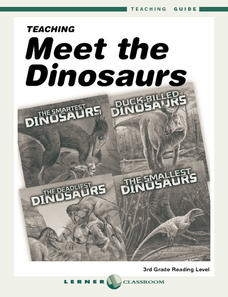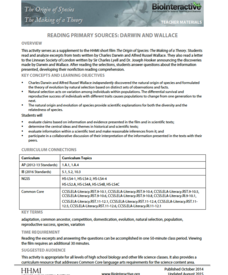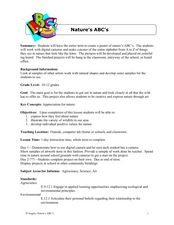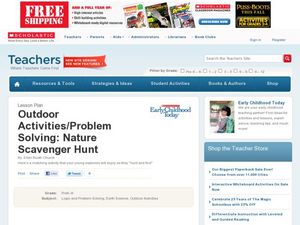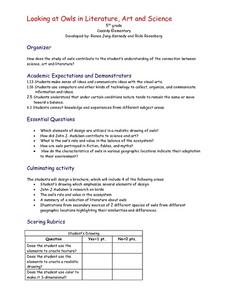PHET
Earth’s Magnetic Field from Space
Feel the pull of science! The final installment of this 18-part series is an application of everything learned in the previous high school lessons. Scholars are given a magnetic field map and must propose an arrangement of magnets that...
National Center for Case Study Teaching in Science
Cell Phone Use and Cancer
The cell phone you're using is making you deaf: news at 11:00. Oftentimes, the media uses fear tactics and other techniques to increase its audience base. In an intriguing look at the difference between scientific journals and...
Lerner Publishing
Meet the Dinosaurs
Take your class of youngsters on a prehistoric adventure with this four-lesson series on dinosaurs. Accompanying the Meet the Dinosaurs books by Don Lessem, these lessons engage children in writing their own dinosaur books,...
NOAA
Ocean Exploration
Where am I? The second installment of a 23-part NOAA Enrichment in Marine sciences and Oceanography (NEMO) program starts with pupils guessing the years in which major ocean exploration events took place. The instructional activity then...
Purdue University
Design of a Door Alarm
How does electricity work? Budding scientists explore the concepts of electrical currents and open and closed circuits with class discussion and a hands-on activity using a battery to turn on a light bulb. Learners also make predictions...
Nature Works Everywhere
Fishing for a Future
Teaching a man to fish has an environmental impact. Through a series of four lessons, learners study the science of fishery management. Their study involves analyzing data to develop a management strategy for specific fish and common...
Illustrative Mathematics
The Lighthouse Problem
Long considered the symbol of safe harbor and steadfast waiting, the lighthouse gets a mathematical treatment. The straightforward question of distance to the horizon is carefully presented, followed by a look into the...
National Wildlife Federation
Life in the Cold: Climate Challenges
What does it take to make it in the Arctic? Learners examine the cold weather adaptations of a polar bear that help it survive. With everyday objects, they model these characteristics as they become make-shift polar bears. Modeling helps...
Howard Hughes Medical Institute
The Making of a Theory—Fact or Fiction
Two scientists, two independent studies, two similar theories! A video lesson presents the work of Charles Darwin and Alfred Wallace that led to their theories on evolution. Scholars then evaluate statements and provide evidence to...
Howard Hughes Medical Institute
Reading Primary Sources: Darwin and Wallace
Take your classes back in time. Learners read real historical texts from both Darwin and Wallace as well as an announcement of their findings. Using guiding questions, they make inferences and draw conclusions from the information in the...
Howard Hughes Medical Institute
Look Who's Coming for Dinner: Selection by Predation
What happens when a new predator comes to town? Learners analyze an experiment that studies the effect of predation on selection. They use real data to draw conclusions about the impact a new predator has on a prey species.
Howard Hughes Medical Institute
How Do Fibers Form?
The proteins inside a cell determine the shape of the cell. While most red blood cells have a circular shape, those with sickle cell take the shape of a sickle. This change in shape causes multiple issues in the system. Scholars solve...
EngageNY
Reading for Gist and Answering Text-Dependent Questions: Chapter 4 of World without Fish
True or false? Scholars read chapter four of World without Fish and explore the idea of a myth. They discuss in triads the meaning of the myth of nature’s bounty. Learners annotate the text on sticky notes and then answer...
Curated OER
Mystery Boxes: Uncertainty and Collaboration
Students manipulate boxes with unknown internal structure and contents to become familiar with the concept of uncertainty in science.
Curated OER
Nature's ABC's
Young scholars will recognize objects in nature that are similar in shape to the letters of the alphabet. In this digital camera lesson, students will find objects in nature that look like letters of the alphabet. They will create a...
Curated OER
Nature: Planting Terrariums
Students observe and experiment using a terrarium. In this scientific lesson plan, students build a nature terrarium. Students then observe their terrarium over a period of time to discover what makes the plants grow. A science...
Curated OER
Nature Calendar
Students practice using reference materials to locate information by making a nature calendar.
Curated OER
Outdoor Activities/Problem Solving: Nature Scavenger Hunt
Students act as young explorers on this scavenger hunt. In this early childhood lesson plan, students build problem-solving and visual discrimination skills as they search outdoors to find matching nature items.
Curated OER
Make a Natural Weaving
Pupils use natural materials and yarn to create weavings. In this natural weaving lesson, students find large branches to act as the loom, use other natural objects to act as designs within the weave, and use fine motor skills to wrap...
Curated OER
The Science of Hurricanes
Students are introduced to the science of hurricanes in an effort to highlight how forces change the speed and direction of motion.
Curated OER
The Science of Hurricanes
Students explore hurricanes. In this science lesson, students discuss the aspects of hurricanes and watch videos of hurricanes. Students discuss the motion of the hurricanes.
Curated OER
Presenting Powerful Outlines for Science Fair Reports
Middle schoolers examine and reflect on the role of science reports in the larger scientific community and become familiar with one scientist's experience preparing a report. They identify key points to build a strong science report and...
Curated OER
Looking at Owls in Literature, Art, and Science
Fifth graders investigate the characteristics of owls through various science and art activities. They analyze drawings by J.J. Audubon and complete a Venn diagram comparing the similarities and differences of different kinds of owls,...
Curated OER
School of Fish
Student explore the natural resources of Buffalo National River. In this natural resources instructional activity ,students discuss the fish and other animals in the Buffalo River. Students discuss what they can do to keep the river...




